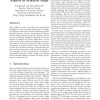Free Online Productivity Tools
i2Speak
i2Symbol
i2OCR
iTex2Img
iWeb2Print
iWeb2Shot
i2Type
iPdf2Split
iPdf2Merge
i2Bopomofo
i2Arabic
i2Style
i2Image
i2PDF
iLatex2Rtf
Sci2ools
120
Voted
FDL
2006
IEEE
2006
IEEE
System Description Aspects as Syntactic Sugar
Many different system description and specification languages are used in modern design flows to emphasize different aspects like modular architecture, multibehavior, abstract action-oriented behavior, and the desired temporal properties. However, the use of many specialized languages complicates the development of seamless and robust design flows. In this paper, we show that synchronous languages are powerful enough to capture the mentioned aspects of system descriptions as simple syntactic sugar. In particular, we show how hardware structures, multi-threaded and action-oriented programs as well as property specification languages can be incorporated in a synchronous programming language so that a single core language with a powerful compiler can handle all design descriptions in a consistent way.
Abstract Action-oriented Behavior | FDL 2006 | Natural Language Processing | Property Specification Languages | Specification Languages |
Related Content
| Added | 22 Aug 2010 |
| Updated | 22 Aug 2010 |
| Type | Conference |
| Year | 2006 |
| Where | FDL |
| Authors | Jens Brandt, Klaus Schneider |
Comments (0)

